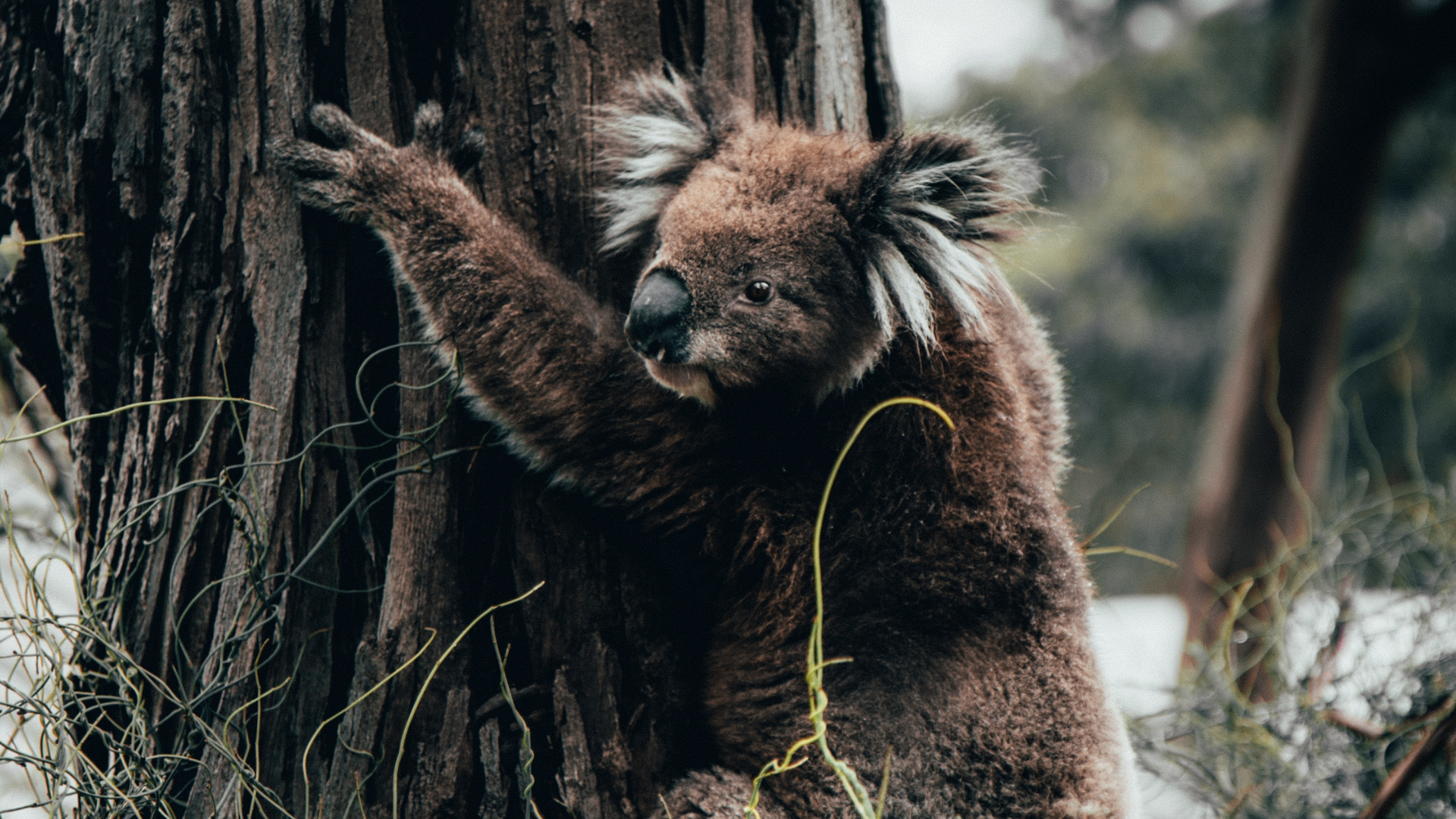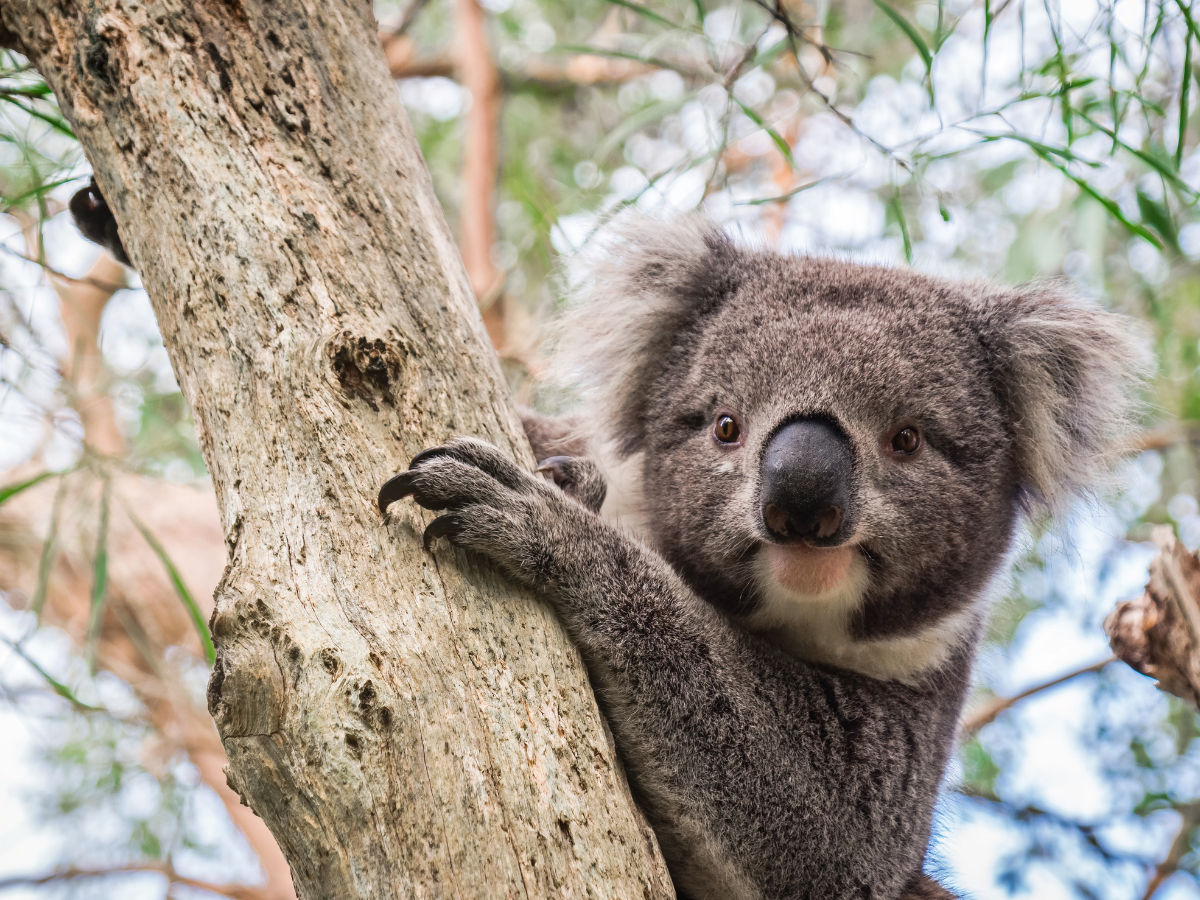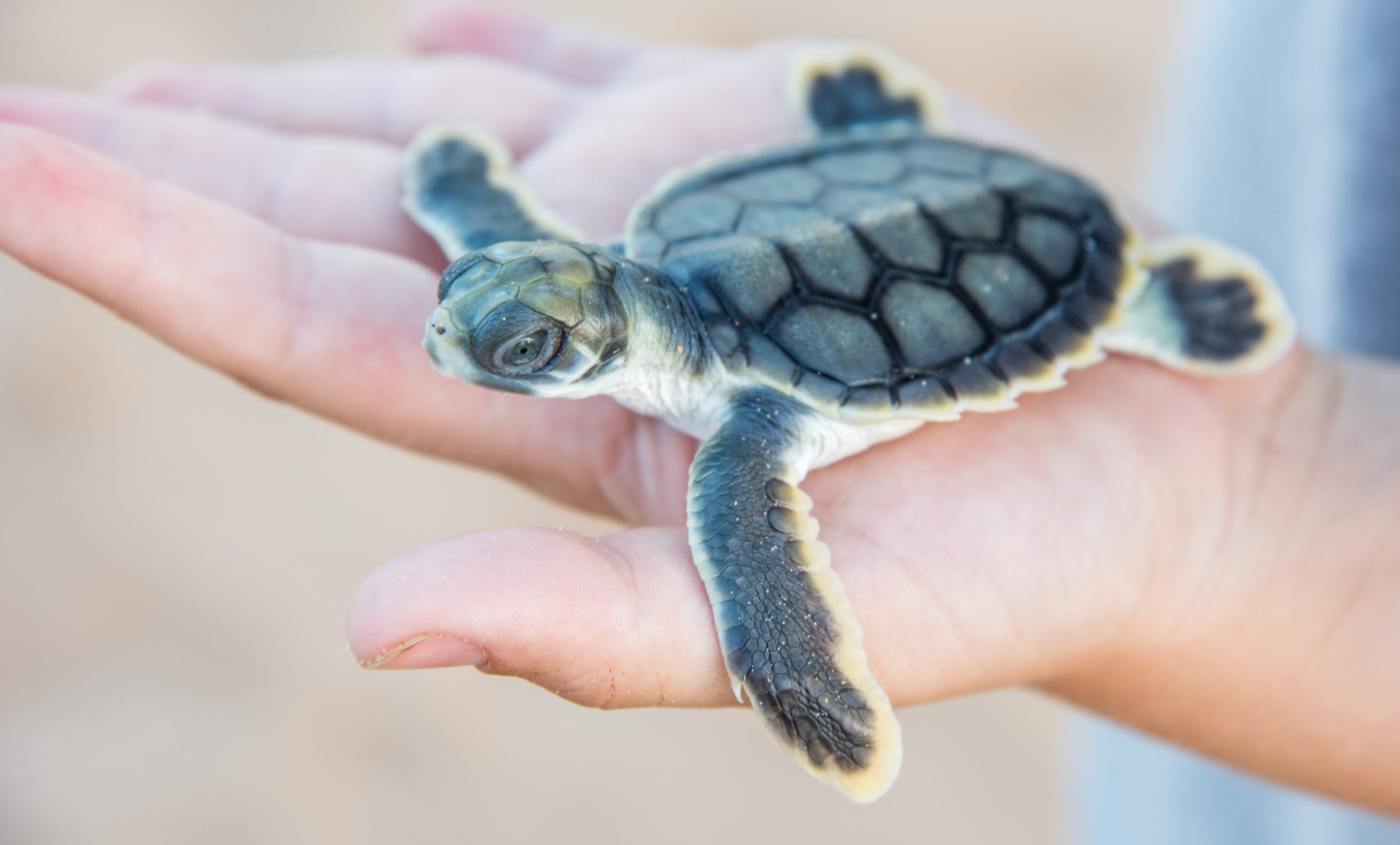
Why are thousands of Australia's animals nationally protected?
We share this continent with some unique and extraordinary wildlife. From the koala to the cassowary, these species have evolved isolated from the rest of the world over tens of millions of years. Many of Australia’s native animals are found nowhere else on Earth. But sadly, more than 500 of Australia’s unique animal species at risk of extinction are listed as threatened under the EPBC Act.
Climate threats to threatened animals
More than 500 of Australia’s unique animal species are currently listed as threatened under the EPBC Act. The effects of climate change will only add to their peril. Of the 403 threatened animal species we reviewed, 368 were identified as likely to be impacted by climate change, including the koala, the Eyre Peninsula southern emu-wren, and the Leadbeater’s possum.
Climate risks to koalas

Koalas (Phascolarctos cinereus) are one of the most loved and iconic Australian animals.
Already endangered in Queensland, New South Wales, and the Australian Capital Territory, the IUCN Red List notes climate change as a threat to koalas, from increased frequency and intensity of drought and high temperatures, bushfires, and reduced habitable area.
Our research found koalas are threatened by wide-scale climate change drivers, which include the increased frequency and intensity of drought and high temperatures, the increasing prevalence of weather conditions which promote bushfire, and a shrinking of climatically suitable area.1
-
Read more evidence on climate risk to koalas
According to the Conservation Advice for the koala:
- The koala is threatened by wide-scale climate change drivers, which include the increased frequency and intensity of drought and high temperatures, the increasing prevalence of weather conditions which promote bushfire, and a shrinking of climatically suitable area.2
- Elevated CO2 levels may also affect the nutritional value of foliage (that are part of the koala’s diet), although further research is needed.3
- Climate change drivers have resulted in a reduction in climatically suitable habitat.4
- Forecasting models predict that a large area of koala habitat may be lost, accompanied by a large reduction in the koala population, under 2070 climate change projections.5
- Modelling of future climate-suitable koala distribution indicates a further contraction by 2030 from the 2011 baseline as a direct result of climate change, of
- 17 to 78% for Queensland
- 8 to 19% for New South Wales
- 169 and 10% for the Australian Capital Territory.6
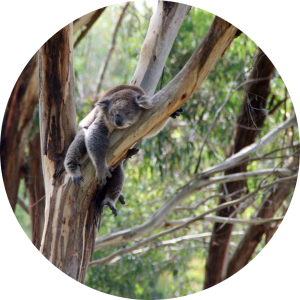
-
Endnotes: Koalas
1 See generally: Conservation Advice, Phascolarctos cinereus (Koala) combined populations of Queensland, New South Wales and the Australian Capital Territory (effective 12 February 2022), 14-17.
2 Conservation Advice, Phascolarctos cinereus (Koala) combined populations of Queensland, New South Wales and the Australian Capital Territory (effective 12 February 2022), 14-17.
3 Conservation Advice, Phascolarctos cinereus (Koala) combined populations of Queensland, New South Wales and the Australian Capital Territory (effective 12 February 2022), 18.
4 Conservation Advice, Phascolarctos cinereus (Koala) combined populations of Queensland, New South Wales and the Australian Capital Territory (effective 12 February 2022), 5.
5 Conservation Advice, Phascolarctos cinereus (Koala) combined populations of Queensland, New South Wales and the Australian Capital Territory (effective 12 February 2022), 6.
6 Conservation Advice, Phascolarctos cinereus (Koala) combined populations of Queensland, New South Wales and the Australian Capital Territory (effective 12 February 2022), 7, 9.
Climate risks and Eyre Peninsula southern emu-wrens

Another example of threatened fauna at risk from more climate damage is the Eyre Peninsular southern emu-wren.
Climate change is a major threat to vulnerable Eyre Peninsula southern emu-wrens (Stipiturus malachurus parimeda), which only live in the southern Eyre Peninsula of South Australia.
The IUCN Red List notes this small bird will likely be exposed to increased frequency and intensity of fires as a result of climate change. Over the last decade, bushfires have severely affected almost all known occupied sites, with the entire population at Koppio Hills lost in a bushfire in 2005.
-
Read more of evidence on climate risks to Eyre Peninsula southern emu-wrens
The IUCN Red List indicates that climate change is a threat to the species.7
According to the Conservation Advice for the species:8
- Climate change is a threat, as the subspecies is considered likely to be exposed to increases in the frequency and intensity of fires as a result of climate change.
- Bushfire is a major potential threat, as it may cause widespread habitat loss. High frequency fires remove vegetation cover used by the subspecies for concealment.
- Over the last decade, bushfires have severely affected almost all known occupied sites, with the population at Koppio Hills lost in a bushfire in 2005.
-
Endnotes: Eyre Peninsula southern emu-wren
8 Conservation Advice, Stipiturus malachurus parimeda (effective 17 December 2013), 2.
Climate risks and Leadbeater's possums
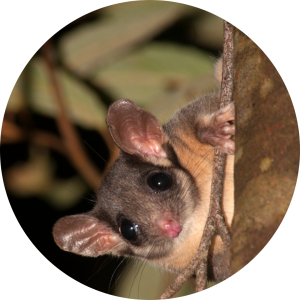
Leadbeater’s possums are another example of threatened fauna at grave risk from climate breakdown.
Victoria’s tall montane ash and sub-alpine woodlands in the Central Highlands provide some of the last remaining habitat for the wollert (Leadbeater’s Possum). These nocturnal possums need the tall canopies and deep hollows of old-growth eucalypts to survive.
This critically endangered possum is threatened by climate change, from both direct mortality and the loss of habitat from increased frequency and intensity of wildfires.9

-
Read more evidence on climate risks to Leadbeater's possums
According to the Conservation Advice for the species:10
- Extensive bushfires are a known threat to the species, with fire resulting in the direct mortality and loss of habitat of the species. The frequency and intensity of wildfires are likely to increase under climate change scenarios, which predict increased rates of extreme climatic events.11
- Collapse of hollow-bearing trees is also a known threat, the rate of which is relevantly influenced by other threats, such as fire.The rate of collapse may also be affected by the effect of climate change on drought and fire.12
- Climate change is a suspected future threat to the species, which may exacerbate existing threats (such as fire frequency and intensity).Other effects may include reduced productivity and recruitment of habitat trees (Mountain Ash).13
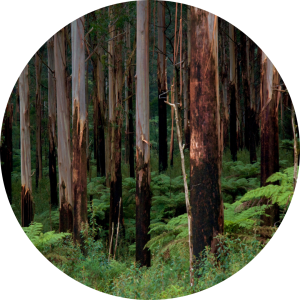
-
Endnotes: Leadbeater's possums
9 Conservation Advice, Gymnobelideus leadbeater (effective 22 June 2019), 4, 2.
10 Conservation Advice, Gymnobelideus leadbeater (effective 22 June 2019).
11 Conservation Advice, Gymnobelideus leadbeater (effective 22 June 2019), 4.
12 Conservation Advice, Gymnobelideus leadbeater (effective 22 June 2019), 5.
13 Conservation Advice, Gymnobelideus leadbeater (effective 22 June 2019), 15.
Which animal species are under threat?
Species that are extinct in the wild
Galaxias pedderensis
Critically endangered species
Acanthornis magna greeniana • Adclarkia dawsonensis • Advena campbellii • Aipysurus apraefrontalis • Aipysurus foliosquama • Ammoniropa vigens • Amytornis modestus obscurior • Anthochaera phrygia • Argynnis hyperbius inconstans • Bidyanus bidyanus • Brachionichthys hirsutus • Calidris ferruginea • Calidris tenuirostris • Carcharias taurus (east coast population) • Chalcophaps indica natalis • Cherax tenuimanus • Cinclosoma punctatum anachoreta • Cophixalus concinnus • Cophixalus hosmeri • Cophixalus mcdonaldi • Cophixalus monticola • Cophixalus neglectus • Crocidura trichura • Cryptoblepharus egeriae • Dryococelus australis • Elseya albagula • Engaewa pseudoreducta • Engaewa reducta • Epthianura crocea macgregori • Euastacus bindal • Euastacus dharawalus • Galaxias rostratus • Galaxias tantangara • Geocrinia alba • Glyphis glyphis • Gudeoconcha sophiae magnifica • Gymnobelideus leadbeateri • Hesperocolletes douglasi • Hoplogonus bornemisszai • Hyridella glenelgensis • Lasiorhinus krefftii • Lathamus discolor • Leioproctus douglasiellus • Lepidodactylus listeri • Lichenostomus melanops cassidix • Limosa lapponica menzbieri • Litoria castanea • Litoria kroombitensis • Litoria lorica • Litoria myola • Litoria nyakalensis • Litoria spenceri • Marginaster littoralis • Mathewsoconcha grayi ms • Mathewsoconcha phillipii • Mathewsoconcha suteri • Melanodryas cucullata melvillensis • Micropathus kiernani • Miniopterus orianae bassanii • Mystivagor mastersi • Nangura spinosa • Neopasiphae simplicior • Neophema chrysogaster • Numenius madagascariensis • Ogyris subterrestris petrina • Ordtrachia septentrionalis • Pedionomus torquatus • Petrogale concinna concinna • Pezoporus flaviventris • Philoria frosti • Phyllurus gulbaru • Potorous gilbertii • Pseudemydura umbrina • Pseudocharopa ledgbirdi • Pseudocharopa whiteleggei • Pseudocheirus occidentalis • Pseudococcus markharveyi • Pseudophryne corroboree • Pseudophryne pengilleyi • Pterodroma arminjoniana • Pterodroma heraldica • Pteropus natalis • Quintalia stoddartii • Stiphodon semoni • Taudactylus pleione • Taudactylus rheophilus • Thersites mitchellae • Thymichthys politus • Wollumbinia georgesi • Zyzomys pedunculatus
Endangered species
Accipiter hiogaster natalis • Adclarkia cameroni • Adclarkia dulacca • Amytornis barbatus barbatus • Amytornis dorotheae • Amytornis merrotsyi pedleri • Antechinus argentus • Antechinus arktos • Antipodia chaostola leucophaea • Arctocephalus tropicalis • Atrichornis clamosus • Atrichornis rufescens • Bellatorias obiri • Bertmainius tingle • Bettongia penicillata ogilbyi • Bettongia tropica • Botaurus poiciloptilus • Burramys parvus • Calidris canutus • Callocephalon fimbriatum • Calyptorhynchus baudinii (Zanda baudinii) • Calyptorhynchus lathami halmaturinus • Ceyx azureus diemenensis • Charadrius mongolus • Cophixalus aenigma • Craterocephalus fluviatilis • Crinia sloanei • Cryptoblepharus gurrmul • Cyanoramphus cookii • Cyclodomorphus praealtus • Cyclopsitta diophthalma coxeni • Cyrtodactylus sadleiri • Dasyornis longirostris • Dasyurus hallucatus • Dasyurus maculatus (SE mainland population) • Dasyurus viverrinus • Dendronephthya australis • Dermochelys coriacea • Egernia stokesii badia • Elseya lavarackorum • Elusor macrurus • Engaeus granulatus • Engaeus martigener • Engaeus spinicaudatus • Engaewa walpolea • Epthianura crocea tunneyi • Erythrura gouldiae • Euastacus bispinosus • Eulamprus leuraensis • Fregata andrewsi • Galaxias auratus • Galaxias fontanus • Galaxias johnstoni • Galaxias truttaceus (Western Australian population) • Galaxiella nigrostriata • Glyphis garricki • Hippocampus whitei • Hipposideros inornatus • Hylacola pyrrhopygia parkeri • Hypotaenidia philippensis andrewsi • Hypotaenidia sylvestris • Isoodon obesulus obesulus • Lerista allanae • Lerista nevinae • Leucopatus Anophthalmus • Liopholis guthega • Liopholis slateri slateri • Lissotes latidens • Litoria booroolongensis • Litoria littlejohni • Litoria watsoni • Lucasium occultum • Maccullochella ikei • Maccullochella mariensis • Macquaria australasica • Macronectes giganteus • Malurus coronatus coronatus • Manorina melanotis • Melanotaenia eachamensis • Melithreptus brevirostris magnirostris • Meridolum maryae • Mesembriomys gouldii gouldii • Mesodontrachia fitzroyana • Mixophyes fleayi • Myrmecobius fasciatus • Nannoperca oxleyana • Nannoperca pygmaea • Neochmia phaeton evangelinae • Neochmia ruficauda ruficauda • Neophoca cinerea • Nesoptilotis leucotis thomasi • Notomys aquilo • Onychogalea fraenata • Oreixenica ptunarra • Papasula abbotti • Paragalaxias mesotes • Paralucia pyrodiscus lucida • Parantechinus apicalis • Pardalotus quadragintus • Petaurus australis australis • Petaurus australis Wet Tropics subspecies • Petrogale coenensis • Petrogale concinna canescens • Petrogale concinna monastria • Petrogale lateralis kimberleyensis • Petrogale lateralis lateralis • Petrogale persephone • Pezoporus occidentalis • Phaethon lepturus fulvus • Phascolarctos cinereus (combined populations of Qld • Philoria kundagungan • Philoria richmondensis • Phyllodes imperialis smithersi • Placostylus bivaricosus • Poephila cincta cincta • Pommerhelix duralensis • Potorous longipes • Psephotus chrysopterygius • Pseudomys fumeus • Pseudomys oralis • Pseudomys shortridgei • Psophodes nigrogularis lashmari (Psophodes leucogaster lashmari) • Psophodes nigrogularis nigrogularis • Pteropus conspicillatus • Rostratula australis • Sarcophilus harrisii • Semotrachia euzyga • Sinumelon bednalli • Sminthopsis psammophila • Sterna vittata bethunei • Stipiturus malachurus halmaturinus • Stipiturus malachurus intermedius • Stipiturus mallee • Tachyglossus aculeatus multiaculeatus • Taudactylus eungellensis • Thalassarche cauta • Thalassarche chrysostoma • Thaumatoperla alpina • Trioza barrettae • Trisyntopa scatophaga • Turdus poliocephalus erythropleurus • Tyto novaehollandiae melvillensis • Uperoleia mahonyi • Zearaja maugeana • Zyzomys palatalis
Vulnerable species
Acanthophis hawkei • Brachiopsilus ziebelli • Calamanthus cautus halmaturinus (Hylacola cauta halmaturina) • Calyptorhynchus banksii naso • Chalinolobus dwyeri • Coeranoscincus reticulatus • Conilurus penicillatus • Engaeus orramakunna • Engaeus yabbimunna • Epinephelus daemelii • Galaxias parvus • Hoplogonus simsoni • Hoplogonus vanderschoori • Idiosoma nigrum • Isoodon obesulus nauticus • Kumonga exleyi • Lagorchestes hirsutus bernieri • Lagorchestes hirsutus dorreae • Liopholis pulchra longicauda • Maccullochella peelii • Macronectes halli • Mixophyes iteratus • Nannatherina balstoni • Neoceratodus forsteri • Nyctophilus corbeni • Oreisplanus munionga larana • Paragalaxias dissimilis • Paragalaxias eleotroides • Parvulastra vivipara • Perameles gunnii Victorian subspecies • Phascogale pirata • Potorous tridactylus trisulcatus • Pristis clavata • Pristis zijsron • Pseudomys novaehollandiae • Pseudomys pilligaensis • Pteropus poliocephalus • Pycnoptilus floccosus • Rhincodon typus • Rhinonicteris aurantia (Pilbara form) • Sternula nereis nereis • Thalassarche melanophris • Tympanocryptis condaminensis • Tyto novaehollandiae castanops (Tasmanian population) • Zyzomys maini
Vulnerable
Thick-billed Grasswren, Grey Range Thick-billed Grasswren, Thick-billed Grasswren (north-west NSW), Thick-billed Grasswren (eastern) (Amytornis modestus)
Western Grasswren (Gawler Ranges) (Amytornis textilis myall)
Shy Heathwren (Kangaroo Island) (Calamanthus cautus halmaturinus (Hylacola cauta halmaturina))
Forest Red-tailed Black-Cockatoo (Calyptorhynchus banksii naso)
Pedra Branca Skink, Pedra Branca Cool-skink (Carinascincus palfreymani)
Cape Barren Goose (south-western) (Cereopsis novaehollandiae grisea)
Greater Sand Plover (Charadrius leschenaultii)
Three-toed Snake-tooth Skink (Coeranoscincus reticulatus)
Brush-tailed Rabbit-rat (Conilurus penicillatus)
Mount Arthur Burrowing Crayfish (Engaeus orramakunna)
Slender-billed Thornbill (Gulf St Vincent) (Acanthiza iredalei rosinae)
Kangaroo Island Striated Thornbill (Acanthiza lineata whitei)
Plains Death Adder (Acanthophis hawkei)
Short-tailed Grasswren (Flinders Ranges) (Amytornis merrotsyi merrotsyi)
White-throated Grasswren, Yirlinkirrkirr (Amytornis woodwardi)
Five-clawed Worm-skink, Long-legged Worm-skink (Anomalopus mackayi)
Australian Lesser Noddy (Anous tenuirostris melanops)
Fawn Antechinus (Antechinus bellus)
Swamp Antechinus (mainland) (Antechinus minimus maritimus)
Kangaroo Island Little Wattlebird (Anthochaera chrysoptera halmaturina)
Pink-tailed Worm-lizard, Pink-tailed Legless Lizard (Aprasia parapulchella)
Flinders Ranges Worm-lizard (Aprasia pseudopulchella)
Giant Freshwater Crayfish, Tasmanian Giant Freshwater Lobster (Astacopsis gouldi)
Sei Whale (Balaenoptera borealis)
Fin Whale (Balaenoptera physalus)
Eastern Stirling Range Pygmy Trapdoor Spider (Bertmainius colonus)
Large-eared Pied Bat (Chalinolobus dwyeri)
Lancelin Island Skink (Ctenotus lancelini)
Hamelin Ctenotus (Ctenotus zastictus)
Dasyuroides byrnei (Dasyuroides byrnei)
Striped Legless Lizard (Delma impar)
Atherton Delma (Delma mitella)
Adorned Delma (Delma torquata)
Ornamental Snake (Denisonia maculata)
Yakka Skink (Egernia rugosa)
Burnie Burrowing Crayfish (Engaeus yabbimunna)
Black Rockcod (Epinephelus daemelii)
Red Goshawk (Erythrotriorchis radiatus)
Grey Falcon (Falco hypoleucos)
Crested Shrike-tit (northern) (Falcunculus frontatus whitei)
Dunmall’s Snake (Furina dunmalli)
Swamp Galaxias (Galaxias parvus)
Saddled Galaxias (Galaxias tanycephalus)
Squatter Pigeon (southern) (Geophaps scripta scripta)
Partridge Pigeon (western) (Geophaps smithii blaauwi)
Partridge Pigeon (eastern) (Geophaps smithii smithii)
Painted Honeyeater (Grantiella picta)
Blue Petrel (Halobaena caerulea)
Giant Burrowing Frog (Heleioporus australiacus)
Semon’s Leaf-nosed Bat (Hipposideros semoni)
White-throated Needletail (Hirundapus caudacutus)
Broad-headed Snake (Hoplocephalus bungaroides)
Simson’s Stag Beetle (Hoplogonus simsoni)
Shield-backed Trapdoor Spider (Idiosoma nigrum)
Golden Bandicoot (mainland) (Isoodon auratus auratus)
Golden Bandicoot (Barrow Island) (Isoodon auratus barrowensis)
Spectacled Hare-wallaby (Barrow Island) (Lagorchestes conspicillatus conspicillatus)
Rufous Hare-wallaby (Bernier Island) (Lagorchestes hirsutus bernieri)
Rufous Hare-wallaby (Dorre Island) (Lagorchestes hirsutus dorreae)
Wopilkara, Greater Stick-nest Rat (Leporillus conditor)
Mount Cooper Striped Skink (Lerista vittata)
Olive Python (Pilbara subspecies) (Liasis olivaceus barroni)
Nunivak Bar-tailed Godwit (Limosa lapponica baueri)
Great Desert Skink (Liopholis kintorei)
Jurien Bay Skink (Liopholis pulchra longicauda)
Green and Golden Bell Frog (Litoria aurea)
- Australian Lace-lid, Lace-eyed Tree Frog, Day’s Big-eyed Treefrog (Litoria dayi)
- Peppered Tree Frog (Litoria piperata)
- Alpine Tree Frog, Verreaux’s Alpine Tree Frog (Litoria verreauxii alpina)
- Ghost Bat (Macroderma gigas)
- Greater Bilby (Macrotis lagotis)
- Broad-toothed Rat (mainland), Tooarrana (Mastacomys fuscus mordicus)
- Black-footed Tree-rat (Melville Island) (Mesembriomys gouldii melvillensis)
- Black-footed Tree-rat (north Queensland), Shaggy Rabbit-rat (Mesembriomys gouldii rattoides)
- Blind Gudgeon (Milyeringa veritas)
- Horsfield’s Bushlark (Tiwi Islands) (Mirafra javanica melvillensis)
- Southern Elephant Seal (Mirounga leonina)
- Stuttering Frog (Mixophyes balbus)
- Giant Barred Frog (Mixophyes iteratus)
- Flinders Ranges Mogurnda (Mogurnda clivicola)
- Balston’s Pygmy Perch (Nannatherina balstoni)
- Southern Pygmy Perch (Murray-Darling Basin lineage) (Nannoperca australis Murray-Darling Basin lineage)
- Australian Lungfish (Neoceratodus forsteri)
- Christmas Island Hawk-Owl (Ninox natalis)
- Dusky Hopping-mouse (Notomys fuscus)
- Corben’s Long-eared Bat (Nyctophilus corbeni)
- Bronzeback Snake-lizard (Ophidiocephalus taeniatus)
- Blind Cave Eel (Ophisternon candidum)
- Marrawah Skipper (Oreisplanus munionga larana)
- Fairy Prion (southern) (Pachyptila turtur subantarctica)
- Shannon Paragalaxias (Paragalaxias dissimilis)
- Great Lake Paragalaxias (Paragalaxias eleotroides)
- Bathurst Copper Butterfly (Paralucia spinifera)
- Eastern Barred Bandicoot (Tasmania) (Perameles gunnii gunnii)
- Greater Glider (Petauroides volans)
- Yellow-bellied Glider (south-eastern) (Petaurus australis australis)
- Brush-tailed Rock-wallaby (Petrogale penicillata)
- Mount Claro Rock Wallaby, Sharman’s Rock Wallaby (Petrogale sharmani)
- Yellow-footed Rock-wallaby (central-western Queensland) (Petrogale xanthopus celeris)
- Red-tailed Phascogale (Phascogale calura)
- Northern Brush-tailed Phascogale (Phascogale pirata)
- Kimberley brush-tailed phascogale (Phascogale tapoatafa kimberleyensis)
- Green Rosella (King Island) (Platycercus caledonicus brownii)
- Kangaroo Island Crimson Rosella (Platycercus elegans melanopterus)
- Princess Parrot (Polytelis alexandrae)
- Superb Parrot (Polytelis swainsonii)
- Long-nosed Potoroo (northern) (Potorous tridactylus tridactylus)
- Long-nosed Potoroo (southern mainland) (Potorous tridactylus trisulcatus)
- Dwarf Sawfish (Pristis clavata)
- Freshwater Sawfish (Pristis pristis)
- Green Sawfish (Pristis zijsron)
- Palm Cockatoo (Australian) (Probosciger aterrimus macgillivrayi)
- Australian Grayling (Prototroctes maraena)
- Honey Blue Eye (Pseudomugil mellis)
- Shark Bay Mouse (Pseudomys fieldi)
- New Holland Mouse (Pseudomys novaehollandiae)
- Pilliga Mouse (Pseudomys pilligaensis)
- Magnificent Brood Frog (Pseudophryne covacevichae)
- Soft-plumaged Petrel (Pterodroma mollis)
- Pilotbird (Pycnoptilus floccosus)
- Christmas Island Blind Snake (Ramphotyphlops exocoeti)
- Fitzroy River Turtle, Fitzroy Tortoise, Fitzroy Turtle (Rheodytes leukops)
- Whale Shark (Rhincodon typus)
- Large-eared Horseshoe Bat, Greater Large-eared Horseshoe Bat (Rhinolophus robertsi)
- Pilbara Leaf-nosed Bat (Rhinonicteris aurantia (Pilbara form))
- Bare-rumped Sheath-tailed Bat (Saccolaimus saccolaimus nudicluniatus)
- Butler’s Dunnart (Sminthopsis butleri)
- Julia Creek Dunnart (Sminthopsis douglasi)
- Sunset Frog (Spicospina flammocaerulea)
- Australian Fairy Tern (Sternula nereis nereis)
- Southern Emu-wren (Eyre Peninsula) (Stipiturus malachurus parimeda)
- Golden Sun Moth (Synemon plana)
- Eastern Hooded Plover (Thinornis cucullatus cucullatus)
- Northern Brushtail Possum (Trichosurus vulpecula arnhemensis)
- Black-breasted Button-quail (Turnix melanogaster)

